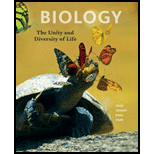
Concept explainers
The type of physical environment in which a species typically lives is its _______.
- a. niche
- b. habitat
- c. community
- d. population
Introduction: The branch of science that deals with the study of the relations among organisms and their physical environment. A group of species that lives in the same geographical place at a specific time is known as community.
Answer to Problem 1SQ
Correct answer: The type of physical environment in which a species typically lives is its habitat.
Hence, the correct answer is option b.
Explanation of Solution
Reason for the correct answer:
The place or the environment in which all the species naturally live and consists of all the biological and physical features that are accessible to a species is known as habitat. All the species living in a specific habitat comprises a community.
Option b. is given as “habitat”.
The place or the environment in which all the species naturally live is known as habitat.
Hence, the correct answer is option b.
Reason for the incorrect answer:
Option a. is given as “niche”.
The role played by the species in order to meet their needs in its community is known as ecological niche. Niche is not the physical environment in which the species lives naturally.
Hence, option a. is incorrect.
Option c. is given as “community”.
A group of species that lives in the same geographical place at a specific time is known as community. All the species living in a specific habitat comprises a community. The community is not the type of physical environment in which the species lives naturally.
Hence, option c. is incorrect.
Option d. is given as “population”.
The number of organisms that live together in the same area is called population. Population is not the physical environment in which the species lives naturally.
Hence, option d. is incorrect.
Therefore, options a., c., and d. are incorrect.
The habitat is a type of physical environment in which the species lives naturally.
Want to see more full solutions like this?
Chapter 45 Solutions
Biology: The Unity and Diversity of Life (MindTap Course List)
Additional Science Textbook Solutions
Campbell Essential Biology with Physiology (5th Edition)
Campbell Essential Biology (7th Edition)
Campbell Biology (11th Edition)
Microbiology: An Introduction
Concepts of Biology
Microbiology: Principles and Explorations
- _________ is the interaction inwhich one species benefits and the other is neither harmed nor benefited.A. Predation B. CommensalismC. Competition D. Parasitismarrow_forwardA group of individuals of the same species living in the same area is called a(n) ________. a. family b. community c. population d. ecosystemarrow_forwardIf a species is no longer able to reproduce, it will a. adapt to its environment b. become extinct c. become immune to disease d. increase its populationarrow_forward
- Dandelions in your yard are an example of _________________. a. none of the above b. intraspecific competition c. parasitism d. commensalismarrow_forwardAn _______species has population levels so low it is at great risk of extinction in the near future. a. endemic c. indicator b. endangered d. exoticarrow_forwardAll members of all species in a certain area is a(an) __________. a. ecosystem b. biosphere c. community d. population e. familyarrow_forward
- Passenger pigeons were driven to extinction________ . a. by introduced pathogens b. by overharvesting c. as a result of global warming d. by competition with introduced birdsarrow_forward____________________________ determine which species can inhabit a place. a. none of the above b. populations c. niches d. habitatsarrow_forwardSome invasive species carry pathogens or parasites with them. Scientists think this might be one reason why some introduced species become invasive. Carrying pathogens or parasites might make an invading species more successful if the invading pathogen or parasite ___________ a. Selectively infects and kills native competitors b. Dies out shortly after entering the new environment c. Loses its ability to infect all species in the new environment d. Selectively infects and kills the invasive speciesarrow_forward
- The current biodiversity crisis is due, almost single-handedly, to ________. a. conservation biology b. humans c. global pandemics d. bacteriaarrow_forwardWhen interspecific competition is weaker than intraspecific competition for both species A & B in the Lotka-Volterra competition model_________________. a. species A wins b. both species coexist c. both species go extinct d. species B winsarrow_forwardOrcas working together to create a current that knocks a seal off of an ice floe is an example of _______________. a. interspecific cooperation b. interspecific competition c. intraspecific cooperation d. intraspecific competitionarrow_forward
 Human Anatomy & Physiology (11th Edition)BiologyISBN:9780134580999Author:Elaine N. Marieb, Katja N. HoehnPublisher:PEARSON
Human Anatomy & Physiology (11th Edition)BiologyISBN:9780134580999Author:Elaine N. Marieb, Katja N. HoehnPublisher:PEARSON Biology 2eBiologyISBN:9781947172517Author:Matthew Douglas, Jung Choi, Mary Ann ClarkPublisher:OpenStax
Biology 2eBiologyISBN:9781947172517Author:Matthew Douglas, Jung Choi, Mary Ann ClarkPublisher:OpenStax Anatomy & PhysiologyBiologyISBN:9781259398629Author:McKinley, Michael P., O'loughlin, Valerie Dean, Bidle, Theresa StouterPublisher:Mcgraw Hill Education,
Anatomy & PhysiologyBiologyISBN:9781259398629Author:McKinley, Michael P., O'loughlin, Valerie Dean, Bidle, Theresa StouterPublisher:Mcgraw Hill Education, Molecular Biology of the Cell (Sixth Edition)BiologyISBN:9780815344322Author:Bruce Alberts, Alexander D. Johnson, Julian Lewis, David Morgan, Martin Raff, Keith Roberts, Peter WalterPublisher:W. W. Norton & Company
Molecular Biology of the Cell (Sixth Edition)BiologyISBN:9780815344322Author:Bruce Alberts, Alexander D. Johnson, Julian Lewis, David Morgan, Martin Raff, Keith Roberts, Peter WalterPublisher:W. W. Norton & Company Laboratory Manual For Human Anatomy & PhysiologyBiologyISBN:9781260159363Author:Martin, Terry R., Prentice-craver, CynthiaPublisher:McGraw-Hill Publishing Co.
Laboratory Manual For Human Anatomy & PhysiologyBiologyISBN:9781260159363Author:Martin, Terry R., Prentice-craver, CynthiaPublisher:McGraw-Hill Publishing Co. Inquiry Into Life (16th Edition)BiologyISBN:9781260231700Author:Sylvia S. Mader, Michael WindelspechtPublisher:McGraw Hill Education
Inquiry Into Life (16th Edition)BiologyISBN:9781260231700Author:Sylvia S. Mader, Michael WindelspechtPublisher:McGraw Hill Education





